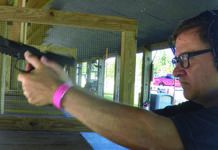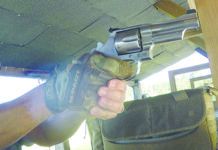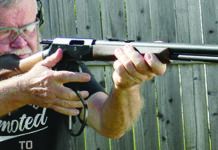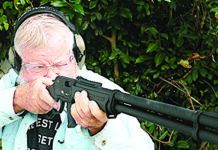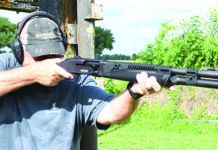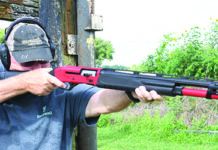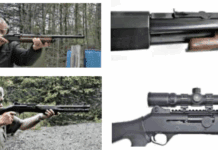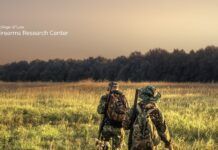The 6.5mm is a popular caliber for both hunting and long-range shooting, and two of the most popular chamberings in this diameter are the 6.5 Creedmoor and the 6.5 PRC. We have most recently covered 6.5 PRCs in the June 2023 issue, looking at the Bergara Premier MgLite, the Christensen Arms MPR, and the Springfield Armory Waypoint 2020 BAW92465PRCCFGA. Most recently, we covered rifles chambered in 6.5 Creedmoor in the August 2023 issue, namely the Savage Impulse Elite Precision 57888, Tikka T3X CTR, and the SIG Sauer Cross 65-18B-FLC.
But if you’re on the fence about which chambering might be better, we explored the variances in accuracy, ballistics, and recoil between these two chamberings when shot shoulder to shoulder, plus we wanted to see if there were any differences in barrel materials. So this time, we pitted two carbon-fiber barrels from Proof Research and BSF against each other and used a stainless-steel sporter-contour barrel to give you a familiar touchpoint in a rifle you might already own.
Here, a Savage Model 100 Ultralite uses a Proof Research barrel, and a Springfield Armory 2020 Waypoint sports a BSF barrel, and a Browning X-Bolt Speed LR employs a steel barrel. The Savage and Browning were chambered in 6.5 PRC and the Springfield in 6.5 Creedmoor. You can read our earlier coverage on these rounds free as part of your subscription, so for more, check the Gun Tests Master Index at Gun-Tests.com and search for “Creedmoor” or “PRC” to see all of the archived material on those rounds.
Cartridges are a lot like personalities; all are a bit different, and some characteristics can endear you or rub you the wrong way. The 6.5 Creedmoor (6.5 CM) was developed in 2007 and grew in popularity almost instantly due to its accuracy, flat trajectory, excellent terminal ballistics, and low recoil. It is an easy cartridge to shoot well, and we have used the round in a variety of rifle tests.
The 6.5 PRC (Precision Rifle Cartridge) was developed in 2013, and it has gained a loyal and growing following. It has all the attributes of the 6.5 Creedmoor as well as more juice for longer distances, making a 1,000 yards seem like a chip shot. The 6.5 PRC has more than 250 fps more velocity pushing the same weight bullet as the 6.5 Creedmoor. The 6.5 PRC uses a larger-diameter case than the 6.5 Creedmoor. The fatty 6.5 PRC cartridge is about 30 percent larger than the 6.5 Creedmoor, so it can fit more powder. A downside is rifles chambered in the 6.5 PRC will have a lower magazine capacity due to the chubby cartridges. Both calibers fire long, skinny bullets that have high ballistic coefficients, so they slice through the air easier than other cartridges, and trajectories are flat. The high sectional density, or the bullet’s weight compared to its cross-sectional area, is high, so the bullet penetrates deeply, which makes them very effective for hunting. The overall length of the each cartridge is very similar, 2.9 inches for the 6.5 PRC and 2.8 inches for the 6.5 Creedmoor, each loaded with a 140-grain bullet. Both can be used in short actions, so your rifle can be trimmer and lighter, which is an asset in a hunting rifle.
Most hunters may (ideally) shoot only one round at an animal during the season, so lightweight hunting rifles are usually outfitted with skinny sporter- or featherweight-contour barrels to reduce weight. However, barrel taper also affects heat response, so a hunter with a skinny barrel on his rifle who needs to shoot more than five shots at time may experience stringing, wherein shot impacts change unexpectedly, growing group sizes. So a skinny barrel saves weight, but it heats up faster, and accuracy can degrade.
Also, the stiffer or more rigid a barrel, the more accurate it usually will be. That’s why target rifles have large-diameter barrels that look like a water pipes. Barrels whip when a bullet is fired through them, causing vibration. The stiffer the barrel, the less vibration and, in theory, the better the accuracy. All barrels vibrate and can shoot great groups as well as bad groups.
All carbon-fiber barrels are built with a steel internal barrel, called a liner, that is wrapped by carbon fiber. The carbon fiber reduces weight and is touted to dissipate heat. Depending on the barrel maker, that carbon fiber is wrapped and bonded using different methods, which we’ll get into later on.
We all want to be like James Fenimore Cooper’s Natty Bumppo and need only one shot to slay a deer or elk. Which of these rifles are best able to accomplish that?
How We Tested
To gather accuracy data, we fired a trio of three-shot groups at 100 yards and allowed the barrels to cool between groups. The next step was to fire three sets of three-shot groups — nine shots in total — in succession, without allowing the barrel to cool. This allowed us to see if accuracy degrades as the barrel heats up. The firing procedure was the same for all rifles. We used a bipod attached to the front sling swivel stud and a toe bag. A CVLife 6- to 9-inch bipod with an M-Lok adapter ($28; Amazon.com) was new to us. The bipod attached to the sling swivel stud on the Savage and Browning. We needed the adapter for the M-Lok rail on the Springfield. The bipod is made of fiberglass. The legs can be independently adjusted from 6 to 9 inches, it weighed only 8 ouches, has no-slip rubber feet, and the legs fold up. For the price, this is good bipod option. We liked how easy it was to adjust and deploy. Attaching the bipod to the stud was tedious and easier when using the M-Lok adapter.
For optics, we attached a Burris Signature HD 5-25x50mm scope ($650; OpticsPlanet.com) and a Primary Arms GLx 4-16x50mm FFP scope ($750; PrimaryArms.com) with an illuminated ACSS-Apollo-6.5CR/.224V reticle.
The Burris scope has a 30mm tube with an FFP illuminated Ballistic E3 reticle. It has six brightness settings and has crosshairs calibrated to popular cartridges. The PA scope has a ACSS APOLLO 6.5CM/.224V reticle that looks like high-school-geometry homework, and at first glance seems complicated. It offered a large field of view with clarity to the outer edge of the lens. The large uncapped turrets have a low profile; clicks are crisp, tactile, and audible. The turrets are also locking and zero resettable. The ACSS Apollo reticle features built-in target ranging and range-adjusted wind holds from 5 to 20 mph. If we owned any of these rifles, we’d create a cheat sheet and tape it to the stock for specific loads. There are horizontal hash marks for compensating for wind, too. Each click is 1⁄4 minute of angle (MOA), and there is a total of 65 MOA for elevation and windage. The exposed turrets are low profile and have a push/pull locking feature. The Burris Signature has a side parallax knob that also contains the battery and allows for brightness adjustment. The clarity of the glass was crisp all the way to the edge. This scope acted like it cost a lot more. The weight of the scope is only 24 ounces, so it won’t bog you down when hunting.
That’s how we started out. Continue reading to find out where we ended up.
Savage 110 Ultralite 57583 6.5 PRC
$1450
Gun Tests grade: B+
The 110 Ultralite was lightweight and offered good accuracy. The action was very stiff. Recoil was slightly more than mild. Accuracy deteriorated as the barrel heated up.

| Action Type | Bolt, 2 lugs, 90-degree lift |
| Overall Length | 44.5 in. |
| Barrel | 24.0 in. long, black carbon fiber/stainless, threaded 5⁄8x24, 1:8 in. 4 GR twist |
| Muzzle Device | None |
| Sights | None, drilled and tapped |
| Overall Height w/o Scope | 5.7 in. |
| Weight Unloaded | 6.0 lbs. |
| Weight Loaded | 6.2 lbs. |
| Magazine Capacity | 2, detachable steel box |
| Stock | AccuFit grey synthetic |
| Stock Length of Pull | 13.7 in., adjustable |
| Stock Drop at Comb | 0.6 in., adjustable |
| Stock Drop at Heel | 0.5 in. |
| Stock Buttplate | Black rubber |
| Stock Bedding | NA |
| Action Finish | Matte black |
| Barrel Finish | Carbon fiber |
| Trigger Pull Weight | 2.0 lbs., AccuTrigger |
| Safety | Ambi 3-position |
| Accuracy Guarantee | None stated |
| Warranty | 1 year |
| Telephone | (800) 370-0708 |
| Website | SavageArms.com |
| Made In | U.S. |
The unloaded Ultralite is an honest 6 pounds sans scope. It is built to be lightweight and features a factory blueprinted action. The weight savings come from lightening cuts in the receiver and the 24-inch Proof Research carbon-fiber barrel. Proof Research wraps the carbon fiber around the steel liner and uses epoxy to bond the carbon fiber shell to the barrel liner. The muzzle was threaded, and we’d add a muzzle brake, because the lightweight rifle moved a lot when we touched off 6.5 PRC rounds. We’d like to tame that movement so we can keep the target in the field of view during recoil.
The barreled action is fitted to Savage’s AccuFit stock, which is adjustable for length of pull and comb height. This is a nice stock that you can easily adjust to give yourself a custom fit. The buttpad is rounded and shouldered nicely, with no snagging. It looks very modern and angular; thank goodness it works and is comfortable shooting the 6.5 PRC.
The trigger is Savage’s nice adjustable AccuTrigger. The test-rifle trigger was set at 2 pounds and that was nearly perfect. To adjust the trigger, you need to pull the stock off the barreled action. We didn’t need that adjustment, so we didn’t take the gun apart.
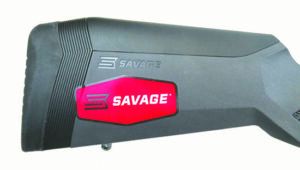
The action was very stiff initially and started to slick up, but we could not palm the bolt to rapidly manipulate the action. The bolt was nicely spiraled to relieve weight and look cool. We needed to purchase bases ($13; JAOutdoors.com) with the larger-than-standard 8-40 screw size. With an MSRP of $1700 for the rifle, we think Savage could have thrown in the mounts. The action wore a good Melonite finish.
The three-position safety is located on the tang for ease of use by both right-and left-handed shooters. There is full Safe setting that blocks the trigger and bolt, a mid-position Safe blocks the trigger but allows the bolt to be cycled, and the third setting is Fire.
The magazine is flush fit and only held two rounds. The magazine took effort to secure in the stock. We had to make sure the mag was fully seated, and on a few occasions, the top round didn’t chamber. We were not a fan of the magazine, but it did function okay for the most part.
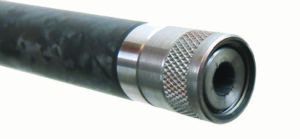
The Savage had the worst accuracy of the rifles tested, but that’s not really a knock on it. The best group measured 0.69 inch with the Nosler Trophy Match, and the Hornady Precision Hunter and Match ammo had best groups that were 0.76 and 0.89 inch, respectively. When we started the rapid-fire test, the Proof Research barrel heated up and accuracy degraded to more than 1 minute of angle. We suspect that the carbon fiber shell, steel liner, and epoxy all have slightly different expansion values as they heated up, so they were not in sync.
Our Team Said: We liked the rifle’s light weight, adjustable trigger, and adjustable stock. The magazine was sticky and the action stiff. Thanks to the carbon-fiber barrel, this is perhaps one of the most expensive Savage rifles we ever fired. Accuracy was sub-MOA with a cold barrel, which is how the rifle would be fired most often, but things went sideways as it heated up. If you want a lightweight rifle that’s affordable pound for pound, then the Savage is an option.
| 6.5 PRC RANGE DATA | ||
| Hornady Match 147-grain ELD Match | Savage 110 Ultralite | Browning X-Bolt Speed LR |
| Average Velocity | 2878 fps | 2911 fps |
| Muzzle Energy | 2708 ft.-lbs. | 2766 ft.-lbs. |
| Smallest Group | 0.89 in. | 0.67 in. |
| Average Group | 0.98 in. | 0.73 in. |
| Hornady Precision Hunter 143-grain ELD-X | Savage 110 Ultralite | Browning X-Bolt Speed LR |
| Average Velocity | 2880 fps | 2910 fps |
| Muzzle Energy | 2634 ft.-lbs. | 2689 ft.-lbs. |
| Smallest Group | 0.76 in. | 0.55 in. |
| Average Group | 0.88 in. | 0.61 in. |
| Nosler Trophy Match 140-grain AccuBond | Savage 110 Ultralite | Browning X-Bolt Speed LR |
| Average Velocity | 2814 fps | 2843 fps |
| Muzzle Energy | 2462 ft.-lbs. | 2513 ft.-lbs. |
| Smallest Group | 0.69 in. | 0.45 in. |
| Average Group | 0.70 in. | 0.57 in. |
To collect accuracy data, we fired three-shot groups from a bench using a rest. Distance: 100 yards. We recorded velocities using a ProChrono digital chronograph set 15 feet from the muzzles.
Written and photographed by Robert Sadowski, using evaluations from Gun Tests Team members. GT





